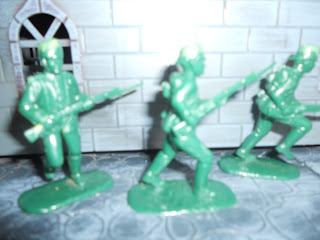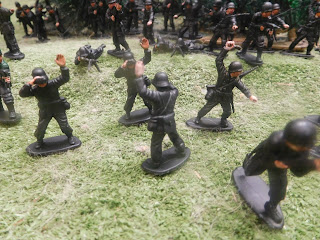Mystery Conversions Painted
Here are the first conversions painted.
The first photo shows two Ruritanians in the 1912 tropical uniform. The Zaneburg solar topee is worn. This was sometimes replaced with the lower profile Salsburg solar topee. The design of the uniform is strongly influenced by the Ruritanian great white hunters resident in New Zendar (formerly South Lionia).
To the right is an Australian from WW2 and the original Airfix figure painted by me over three decades ago. The original is slightly taller.
The solar topees show signs of wear (an excuse for inconsistent modelling!).
American sailors from the occupation of Vera Cruz, Mexico. The white uniforms were dyed light khaki. The figures' caps were cut down from the WW2 helmets. The figure was a copy of the Airfix American, a great pose for conversions of late 19th and early 20th century troops.
Ruritanian artillery officer. late 19th to early 20th century.
The first photo shows two Ruritanians in the 1912 tropical uniform. The Zaneburg solar topee is worn. This was sometimes replaced with the lower profile Salsburg solar topee. The design of the uniform is strongly influenced by the Ruritanian great white hunters resident in New Zendar (formerly South Lionia).
To the right is an Australian from WW2 and the original Airfix figure painted by me over three decades ago. The original is slightly taller.
The solar topees show signs of wear (an excuse for inconsistent modelling!).
American sailors from the occupation of Vera Cruz, Mexico. The white uniforms were dyed light khaki. The figures' caps were cut down from the WW2 helmets. The figure was a copy of the Airfix American, a great pose for conversions of late 19th and early 20th century troops.
Ruritanian artillery officer. late 19th to early 20th century.















Comments
Post a Comment